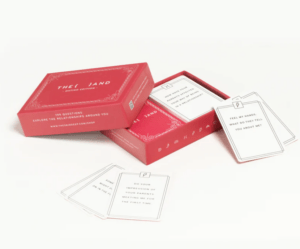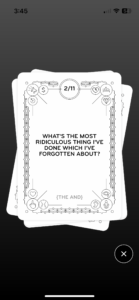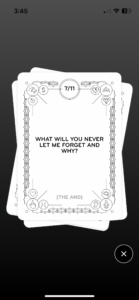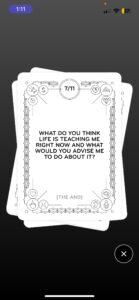For this week’s critical play I decided to do an analysis on a popular get to know you game called “{THE AND}” from The Skin Deep, an organization that designs video and interactive content to foster vulnerability and connection. Although there are physical card sets, I am going to be analyzing game plays done on their digital app platform. I admittedly am a lover of “Getting Vulnerable” type games. I have a long history of making friends, family, roommates, and partners play games like {THE AND}, We’re Not Really Strangers, and the NY Times 36 Questions to Fall in Love. These games have been a wonderful avenue for fostering conversation and growth in these relationships.
Target Audience:
{THE AND} Distinguishes itself from some of the aforementioned Getting Vulnerable games in that it provides a wide variety of card sets to chose from spanning levels of “seriousness” and different person-to-person relationships (co-workers, couples, dating, friends, etc.). On the company website, they market {THE AND} as a game right for anyone who is interested in asking the “bigger questions” and going “beyond the surface” which aligns with the company name and marketing as “The Skin Deep”; an organization on a mission to create space for exploring connections.
Formal Element:
The game’s formal elements work to do just this as the overall aesthetic of a few game plays provide more of an explorative feel than some of its counterparts. In playing games like”36 Questions”, it feels more obvious that the goal is vulnerability, and players showing up to such a game can expect to honor the seriousness that such a game requires.
I had the pleasure of playing a few rounds of {THE AND}’s “{Blind Spots}” 11 card deck that is meant for couples. It felt apparent that the cards were thoughtfully curated to provide a mix of serious and lighthearted offerings that never compromise the goal of exploring the players’ connection.

Mechanistically, the game markets towards two player rounds, but there are only a few surmountable things in the physical or digital design of the game that limit playing with larger groups. One thing is that (at least in the {Blind Spots} card deck), the players are first asked to look into each other’s eyes for a few seconds before beginning to answer the questions. This may not show up in other card decks like those in the “Co-workers” or “Strangers” set. Regardless, I have played rounds of decks in this game with more than one other person and I’ve always ignored that first instruction (even with just one other person).

Still, it is understood why this initial game mechanic is included. It can be thought of as an aside from the actual game play, but I see how the “look into each other’s eyes” mechanic provides an alternative form of fostering connection than the game’s main method; non-verbal vs verbal. It would be interesting to see versions where more cards incorporate this element of non-verbal communication and presence.
Moving along on the game mechanics and formal elements, after staring into each other’s eyes, the game is very simple in that each player takes turns answering the question in front of them. One round is complete after both players answer the question. To move to the next round, on the digital platform, a player is allowed to swipe to the next question.
Everything from the black interface, swiping signifiers for the digital card deck, elegant typography, and gentle yet profound questions made the {Blind Spots} card deck a very gentle, relaxed, and calming game play, which translated into a similar dynamic amongst myself and the other player. This then achieves the overall aesthetic of Fellowship and Expression.
The game moves slow but that is the intent. It feels like you are winning the game if:
1) the questions aren’t too hard to come up with an answer for
2) you are delighting in answering the questions and hearing answers from your game partner
3) The questions are ones you wouldn’t so easily think to ask outside of the game setting
A plus that I experienced is allowing for those questions to spark conversations and rabbit holes that lead to a well of insights about the other player and yourself that you could not have predicted. In playing two settings of this same card deck, I also realized that the 11 chosen questions aren’t the same! This is a huge plus for returning fans of the game, as it provides encouragement that there’s always something new to offer in repeated plays.
Why Does This Game Work:
I’ve alluded to it a few other times in my analysis but I think the game can be considered more successful than other games in its genre because it does not take a one sized fits all approach but really provides a very successful variety of offerings for the type of conversations you are looking to have with your game partner(s) in that moment. Additionally, with an average 8-14 size card deck, with a question for each card, the game is contained to only a few questions. Its competitors like We’re not Really Strangers or 36 Questions either offer a much longer set of questions before the game is “complete” or give you the option to complete the game whenever you wish. There is something nice about giving players the chance of finishing and completing a reasonable goal by making a game play relatively short. And this further welcomed the opportunity for players to take their time in exploring each question and creating meaningful conversation out of it as opposed to trying to rush through the deck to get as much in as possible (experiences I’ve had with the aforementioned other games). It also does not necessarily offer a slow progression in vulnerability like these other games,. I think this is actually a major plus in that it eliminates a feeling I know I’ve had before with progression vulnerability games where I’m like “okay when are we gonna get to the good stuff”. With players that hate the vulnerability part, I’ve experienced them hoping the game stops before we get there. With {THE AND} cards, the players can chose a deck that feels like the right “vulnerability” fit for them at the moment, and you can more expect that each card has something equal to offer as the rest in the deck. This may also contribute to the feeling of appropriate pacing that I got while playing the {Blind Spots} card deck.
All in all, I am a huge fan of this version of a “Getting Vulnerable” game. In thinking about opportunities for improvement, I can only think of what I mentioned above which was experimenting with the ways cards can prompt players to foster non-conversational connection. Could it be players are prompted to play a quick round of converge to see how good the two players may be at converging on a word? Could it be playing a quick round of a hand clapping game together like “Numbers” for some light-hearted and funny physical connection? The opportunities are ripe!








